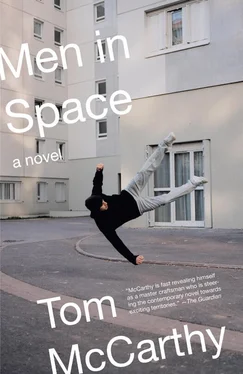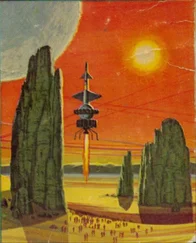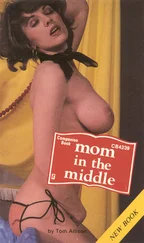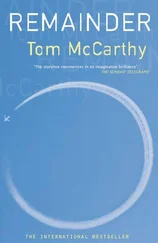Shortly after this conversation, I was forced to hand over my earphones to one of my men by a ringing which had developed in my ears due to their extended exposure to a source whose signal-to-noise ratio was, as previously indicated, less than ideal. As bad luck would have it, council workmen were removing the loudspeakers from beneath the street lamps on Lidická, and their activities caused further interference to our reception. I left the car and remonstrated first with these men and then their supervisor, divulging my identity and role to him. To my great dismay, he professed himself completely indifferent to these, and went as far as to question the integrity and, indeed, sexual orientation of the entire police force. Something like this would never have happened three years ago; a person in his position would immediately have acquiesced to any demand a person in my position might have made. Listening to him speaking, I was struck by a phenomenon of which I had been theoretically aware but the full reality of which I had never had to face until this moment: people are not afraid of us any more. We have, in effect, suffered the same fate as Byzantium.
I have sent my men home. It is Christmas. In 1 [one] week our new state will be born. I sit in my listening post alone, listening. The ringing in my ears is growing quite persistent. During a previous conversation either by phone or in person, Jelínková informed Maňásek that zographs have always reprised previous images, mutating these as they repeat them. Listening to Maňásek and Jelínková’s conversations, I have the impression I am tuning in, through them, to something quite archaic, or at least picking up its echo, its mutated repetition, or its muted one. Maňásek works in silence. Nobody has called or visited him for more than 24 [twenty-four] hours now, and yet something is emerging, beginning to speak: of this I am certain. I do not know if it is the cold or this fact itself which makes me shiver. At 8:25 [eight twenty-five] this morning I was awoken by late revellers dancing over my car’s bonnet …
* * * * *
c/o Martin Blažek etc .
26th December 1992
My dear Han ,
What beastly people these are! Do you know what they eat for Christmas? Carp: those ugly, tasteless fish that anglers of civilized nations, when they’ve landed one, unhook and chuck straight back. Here, they serve them up in fillets, breaded, with horseradish sauce — not that any amount of this can hide their lack of flavour. What’s really gross, though, is the way they harvest them. In the weeks leading up to Christmas, tanks are set up in the streets, and tons of the things are poured into these — alive, no less, like lobsters in good restaurants. People queue up and buy them from men who fish them out and slaughter them right there in front of their eyes. For a docile, peaceful people, the Czechs show an alarming degree of interest in the spectacle, gathering in crowds around the tanks to watch. It is rather surreal, I must admit: the streets running red with blood; piles of gut and head and scale accumulating about the pavements like so many Juan Gris collages …
I celebrated Our Lord’s birth with Martin and Olga, Martin’s charming wife; also her sister and her sister’s husband from Slovakia. The table talk was all about the impending separation. It’s to take place on the stroke of midnight, just as 1992 lurches and vomits into 1993. Slovakia was an independent state before, during the belle époque of World War Two, when Hitler turned it into a Nazi satellite. Its people seem to have lost little of their kindness and compassion in the intervening years: their elected leader is a man named Mečiar, by my hosts’ accounts a jumped-up little Mussolini who intends to start his reign by walling Gypsies into ghettos to venture out of which they’ll have to carry passports . Plus ça change . I bet they love queers there. Martin’s brother-in-law is convinced that Mečiar had Dubček murdered — the leader of the ’68 Prague Spring who died in a car crash last month. Turns out he was en route to spilling the beans on the old communist regime’s more shameful secrets to some official hearings — and that the main subject of his imminent testimony was this very same Mečiar, who was trailing well behind him in the polls for first Slovakian president. The usual conspiracy props littered the brother-in-law’s rap: missing documents, an uninjured driver, a disappearing mystery car: their own JFK myth. Kind of droll, but tedious after a while. So when the Becherovka (don’t ask) came out, I unhooked my jaw, slipped the landing net and went to visit my new friend Ivan Maňásek .
I found him busy copying an icon painting. Most artists here earn their keep by restoring old art; copying it, though, is something I’d not come across before outside of AVU, the main art school which I visited with Martin on my second day here, where the students spend their entire first year mechanically reproducing the statues and murals dotted round the studios. I’m still not quite clear about why or for whom Maňásek was copying this work — but he was taking the job very seriously. I’d not realized the degree of coding that goes on in these religious paintings. There’s the visual coding, of course — but also a whole system of pre-visual formulae that regulate the spatial layout of the whole thing. Pythagorean and Platonic notions about geometric form get trawled through a medieval mesh to throw up the numbers three, four and one — corresponding to the shapes of the triangle (three sides), the square (four) and the circle (you guessed it: one). Which in turn correspond to the Trinity (father, son, ghost), the earth (four corners: NSEW) and the Divine Unity — one-sided, round and seamless, like your mouth, or … anyway, it gets really complicated: modulations within these shapes require the artist to develop root rectangles from a given square, along the lines of  etc, spirals within rectangles, pentagons within circles, Heaven knows what else .
etc, spirals within rectangles, pentagons within circles, Heaven knows what else .
All of this has to be calculated and transposed before a single drop of paint is placed onto the wood. Maňásek had a calculator out and was furiously tapping figures into it, folding and refolding pieces of grease-proof paper, subdividing the divisions with a pencil and so on. You have to find the “Golden Section”, a kind of Bermuda triangle — although it’s nothing so simple as a triangle — in which the “divine mystery” resides. It’s positively Gnostic. Sorry if I’m going on, but I did get really drawn into it. There was the material side too: Maňásek’s kitchen, former scene of cunnilingus interruptus , had become a pharmacy full of pots of whale-blubber-like sauce. In the main room there were compasses and scalpels — and, of course, these endless pages full of charts and calculus. It looked like a cross between an operating theatre and a navigator’s map room .
The subject itself showed a human figure floating above a sea, beside a mountain. There was a building at the bottom of the image, with blackened windows which reminded me of your studio on Windtunnelkade. They also looked like Maňásek’s own skylights, which are filthy. It was more than just a building: more a set of buildings joined together to form a kind of city, with staircases and levels running into one another like the Escher where the water runs round and round stone passages. There was a sea, or ocean, and a set of ships — oh, and a mountain with strange birds perched teetering on it. But the oddest thing was the oval shape of the saint’s golden halo: it was like a hole into which he was disappearing head first. All the rest of the image was flat and depthless and without background, kind of blandly omnipresent — but then suddenly you got this other dimension entirely: an absence, a slipping away. When I asked Maňásek about it he told me that the visual motif was called ellipsus , but added that this motif didn’t properly belong to this type of image. For some reason, he was copying the painting twice, so there were three saints, three mountains, three oceans, goodness knows how many ships, being formed in front of me while I sat drinking coffee after coffee …
Читать дальше

 etc, spirals within rectangles, pentagons within circles, Heaven knows what else .
etc, spirals within rectangles, pentagons within circles, Heaven knows what else .










